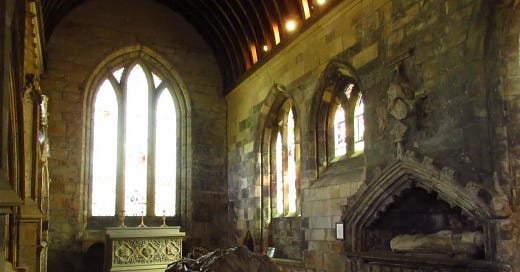The Lady of Douglas: A Crawford's Tale in Stone
In the heart of Lanarkshire, within the solemn and sacred walls of Douglas Church, lies a remarkable piece of history—an effigy that not only captivates with its silent beauty but also tells the story of a lineage that has been instrumental in shaping the narrative of Scottish nobility. This effigy, a masterful work of medieval art, commemorates a lady from the Crawford family, a name synonymous with valor, strategic acumen, and a profound influence on the socio-political landscape of Scotland.
The lady immortalized in stone is believed to have been a vital link between the Crawford family and the Douglas clan, two of the most powerful and revered families in Scottish history. This marriage was not just a union of two individuals but a strategic alliance that fortified the positions of both families in the complex tapestry of Scottish nobility. Such alliances were the bedrock upon which the stability and power of noble families rested, often determining the course of history itself.
Delving Deeper into the Artistic Mastery
The effigy stands as a testament to the extraordinary craftsmanship of the medieval period, showcasing the intricate detailing and profound artistry that went into its creation. It is not merely a representation of a person but a narrative in stone, capturing the essence of the individual's status, the fashion of the era, and the solemn dignity accorded to those of noble descent. The precision of the sculpture, from the folds of the garments to the serene expression on the face, reflects a deep understanding of human anatomy and a respect for the deceased's social stature.
This effigy also serves as a poignant reminder of the pivotal role that women played in the dynamics of power and politics in medieval Scotland. Through strategic marriages, women like the Crawford lady were instrumental in forging alliances that could change the fate of clans and influence the political landscape. These women, often moving silently in the background, were the linchpins in the preservation and expansion of their family's influence and legacy.
Beyond its historical and artistic value, the effigy is a profound commentary on the human desire to be remembered. In a time when life was precarious and the memories of the deceased could easily fade into obscurity, such memorials served as a defiance of mortality, a way to etch one's existence into the annals of history. It reminds us of the medieval mindset, where death was a constant companion, and the legacy one left behind was the true measure of one's life.
The Crawford Legacy: A Beacon for Future Generations
For descendants of the Crawford family and enthusiasts of Scottish history, the effigy is more than just a piece of stone; it is a beacon that connects the past with the present. It offers a tangible link to ancestors whose lives were intertwined with the major events and tumults of Scottish history. It also serves as an inspiration for those who seek to understand and preserve their heritage, providing insights into the values, aesthetics, and social structures of medieval Scotland.
The preservation of such artifacts is crucial for the collective memory and identity of Scotland. They are not just relics of the past but symbols of a rich cultural heritage that continues to influence contemporary Scottish society. The effigy in Douglas Church, along with other historical monuments, plays a vital role in education, offering a window into the past for scholars, students, and tourists alike.
A Monument to History and Artistry
The effigy of the Crawford lady at Douglas Church is a masterpiece that transcends time, offering us a glimpse into the world of medieval Scotland and its noble families. It is a story carved in stone, of alliances and legacies, of artistry and memory, of the silent yet profound influence of women in shaping the course of history. As we stand before it, we are reminded of the enduring power of heritage and the timeless quest for immortality through legacy. It beckons us to delve deeper into our past, to learn, to remember, and to honor those who have paved the way for the present and the future.





